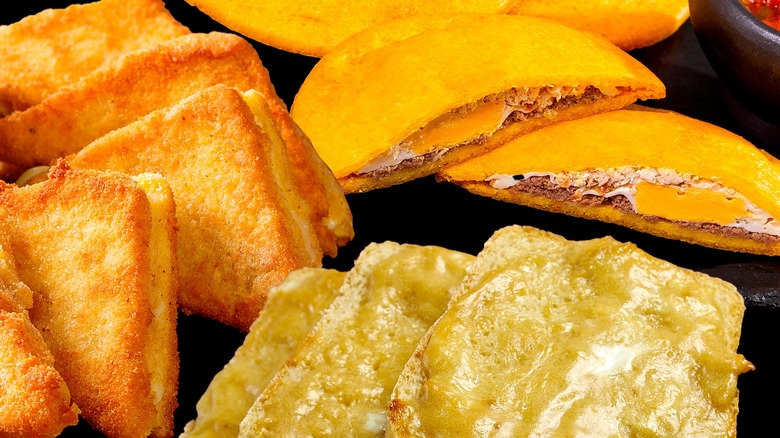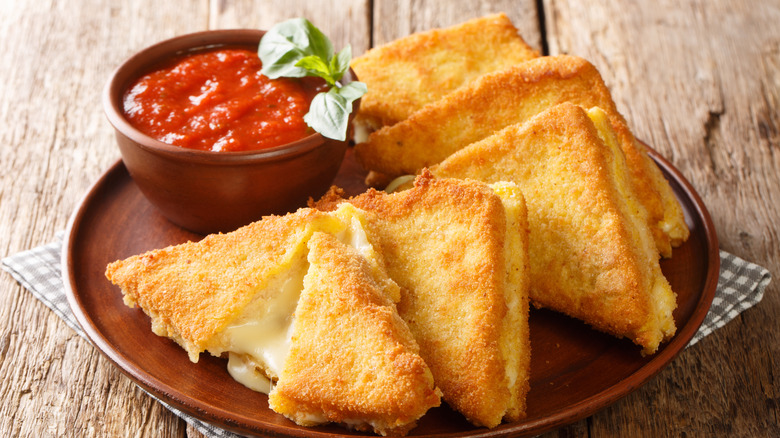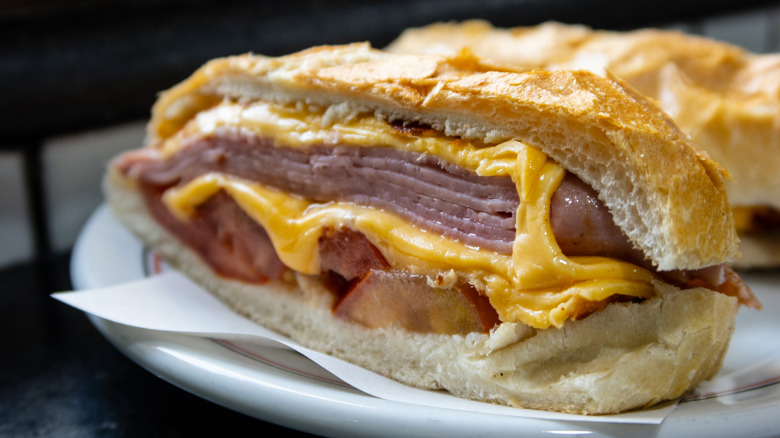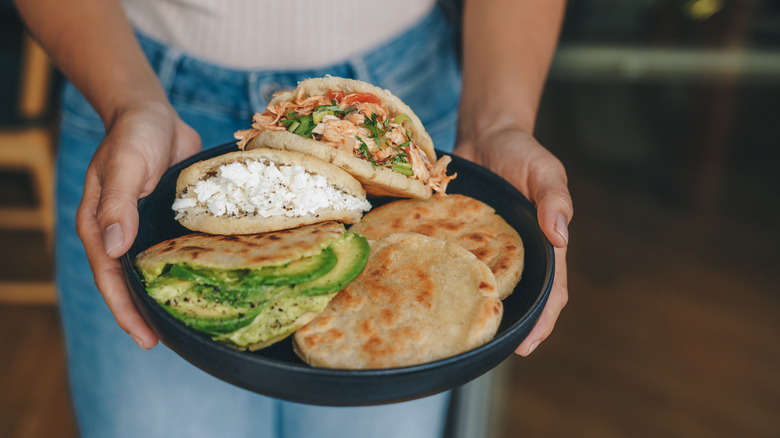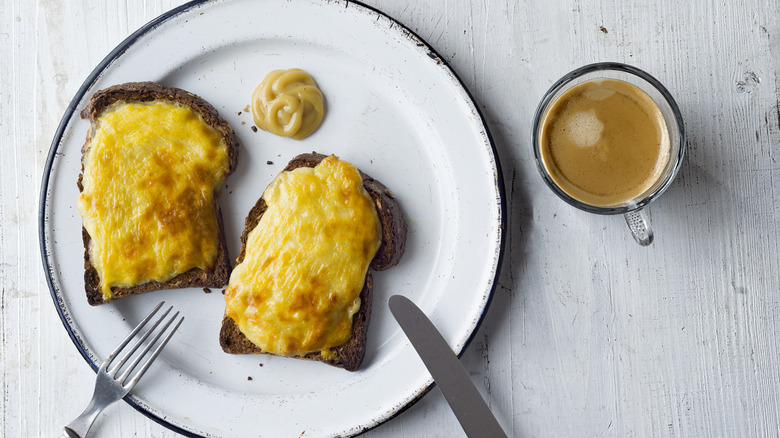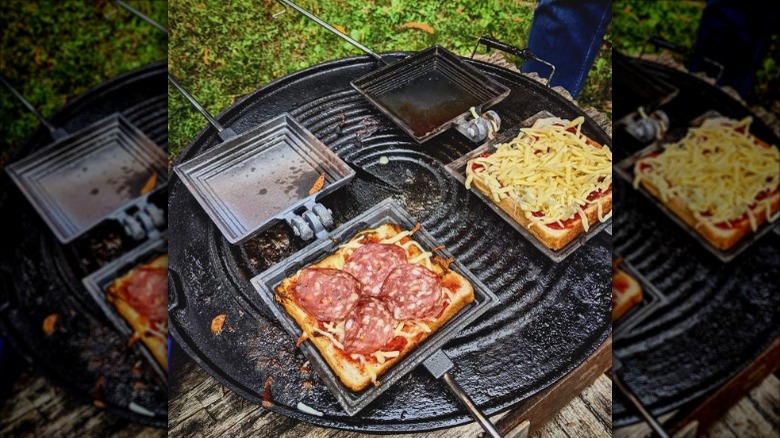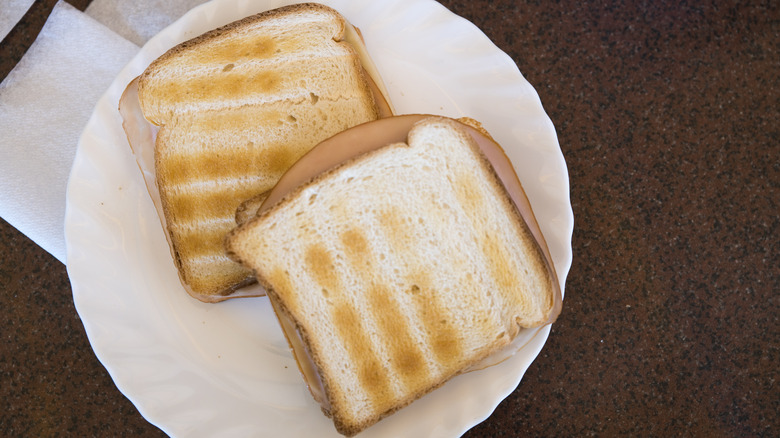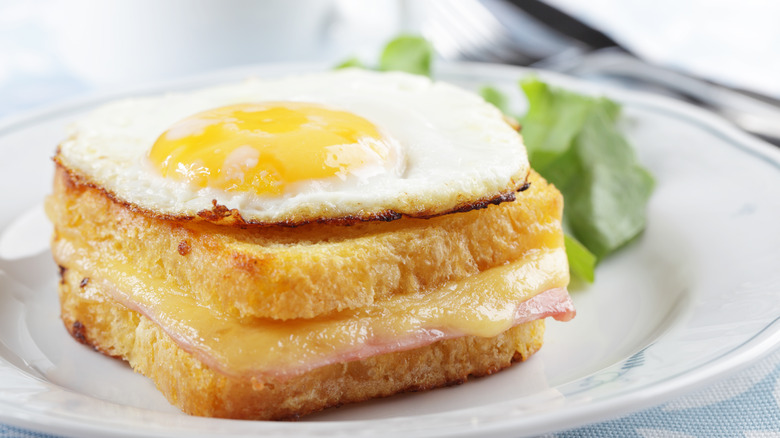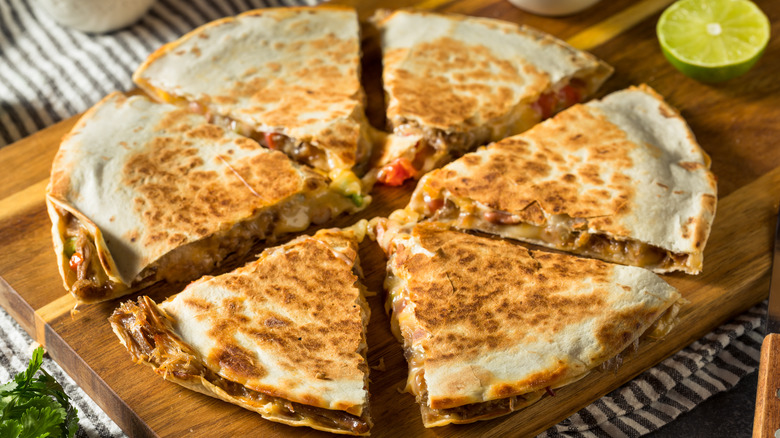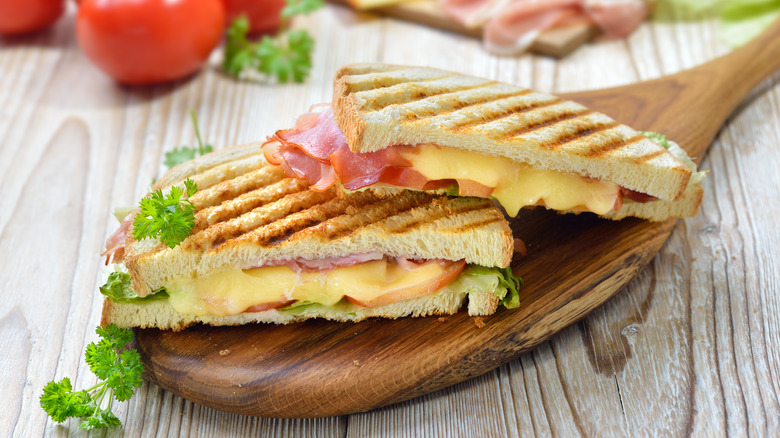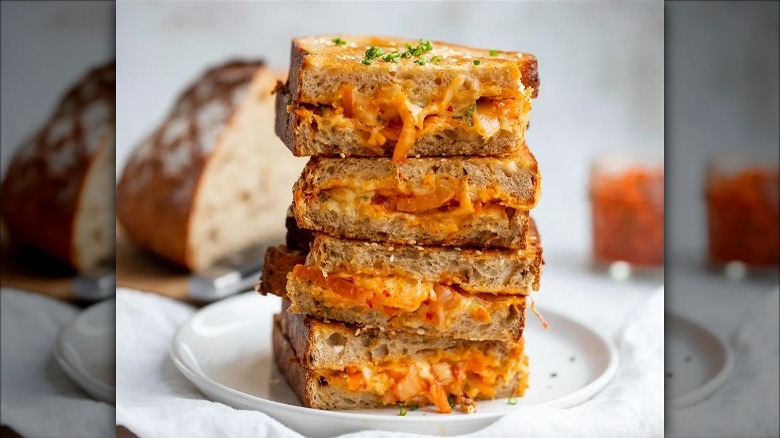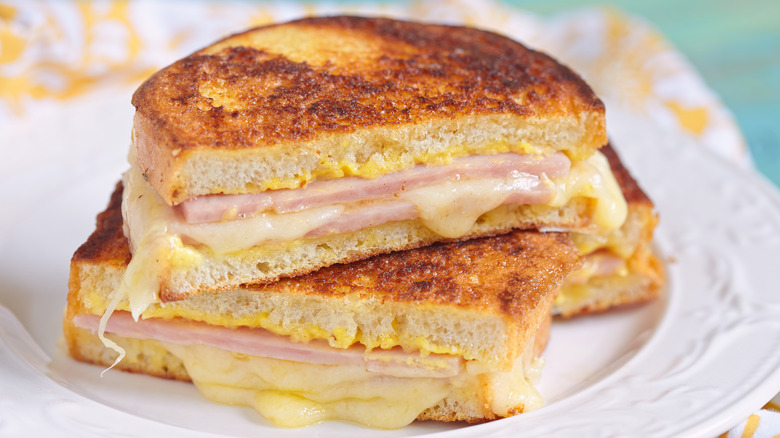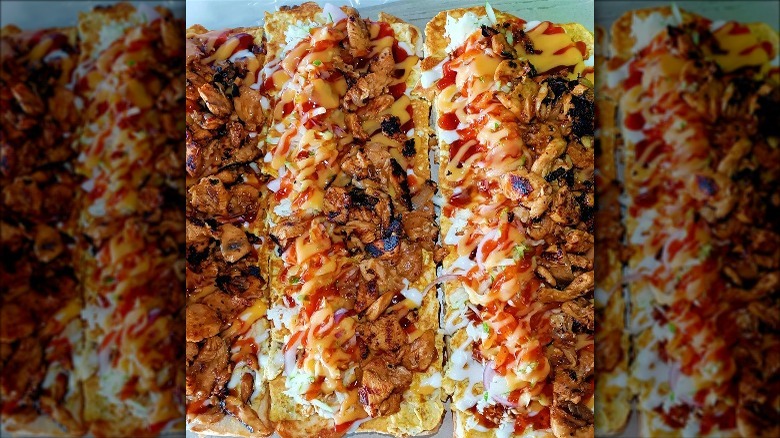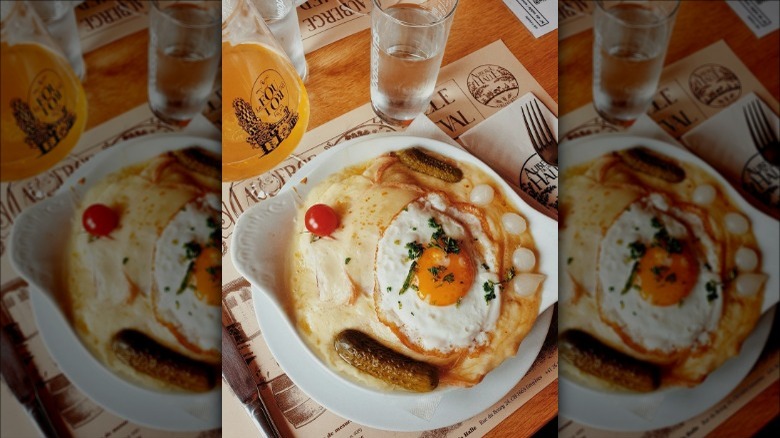14 Chef's Kiss Ways People Enjoy Grilled Cheese From Around The World
Grilled cheese is such a familiar comfort food that it's hard to imagine our national cuisine without it. It turns out that a lot of other countries feel the same. All over the place, from Southeast Asia to South America, cooks have developed their own unique versions of grilled cheese that reflect unique histories and culinary tastes. There's the British toastie, the Brazilian Bauru, and, of course, the French croque monsieur. There is also a surprising number of other variations involving everything from pineapple to kimchi.
The history of grilled cheese stretches back a couple thousand years to when the Romans served heated cheese on bread. Since then, the classic combination has imprinted itself in households and on restaurant menus across the globe, becoming a ubiquitous yet humble staple. Though you may be partial to good old-fashioned American cheese on toast, the variations that you'll find might convert you to a whole new world of grilled cheese possibilities.
1. Mozzarella in carrozza (Italy)
Italian food conjures mouth-watering images of spaghetti laden with Parmesan and paper-thin pizza crusts bowing under the weight of melting mozzarella, but there's more to the country's famous carbs-and-cheese obsession than pasta and pizza. Mozzarella in carrozza is a cheesy dream of a Neapolitan dish that bears more resemblance to a sandwich version of mozzarella sticks than a classic grilled cheese. To make it, simply put mozzarella between two slices of bread, drench it with beaten eggs, and coat all the sides with breadcrumbs to seal in the cheese. Then, fry it in a skillet until it's browned and crispy.
Mozzarella in carrozza has been a popular dish in the southern region of Campania since at least the early 1800s when it was a handy way for poorer households to use up stale bread and days-old mozzarella. Translated to "mozzarella in a carriage," the origins of the name are disputed. Some claim it has to do with the appearance of the sandwich, where the stringy cheese resembles the reins of a carriage and the bread, which was traditionally round, resembled wheels before the introduction of square slices. Others claim it has more to do with the fact that, in the 1800s, transporting milk in carriages often led to curdling, turning the fresh dairy into something akin to mozzarella. Wherever the name came from, the dish is the perfect combination of crunchy, gooey, and easy to make, a holy grail for grilled cheese lovers the world over.
2. Bauru (Brazil)
It isn't often that you eat a sandwich that's sanctioned by the government, but the Bauru is a legally recognized food in Brazil. Since it was created by a law student in São Paulo in the 1930s who named it after his hometown, the Bauru has become a fixture of casual restaurants throughout the country, prompting the São Paulo government to pass a law in 2018 defining it as an intangible part of the heritage of the state. About 20 years prior to that, a law was passed that outlawed anyone from calling a sandwich a Bauru unless it was made with French bread, roast beef, tomato, sliced pickles, mozzarella, oregano, and salt. Additions and omissions are strictly prohibited if the name Bauru is to be attached to the sandwich.
You might be thinking that this level of distinction and regulation is too much for one sandwich to bear, but the Bauru is worthy of its hype and deceptively simple to make (just be sure not to add or omit any ingredients). Top a French bread roll with roast beef, tomato, sliced pickles, oregano, and salt before adding the mozzarella. Traditionally, the cheese is melted in hot water before being added, which may or may not remove some of the excess fat. But don't be fooled. There is nothing remotely health-conscious about this cheesy concoction, which is one of its greatest selling points.
3. Arepa (Venezuela and Colombia)
You've heard of tacos and quesadillas, but if you haven't tried arepas, you're missing out. They are a product of Venezuela and Colombia but are popular throughout South America. The foundation is a corn-based cake comparable to a tortilla in pancake form. People in Venezuela and Colombia have different ways of making arepas. In Venezuela, they're made with cornmeal and water and either grilled, fried, or baked. They're frequently eaten as a plain accompaniment to main dishes, or stuffed with any fillings you can dream up (cheese and black beans are popular, along with avocado, chicken, and mayonnaise). In Colombia, arepas are thinner, sweeter, and usually contain only cheese, which is heaped on top instead of inserted in the middle. This simple recipe makes the Colombian version a delicious alternative to grilled cheese, but the maximalist approach of the Venezuelan tradition offers countless options.
Arepas have a long history. They were likely created by the Timoto-Cuica people who lived in the mountainous region of modern-day Venezuela and Colombia between 800 to 1200 A.D. and developed a highly sophisticated agricultural system. When Venezuela split from Simón Bolívar's Gran Colombia in 1830 and established independence, both countries created their own national spin on the recipe. Whether you choose a thinner, cheese-heaped Colombian arepa or a thick, full-to-bursting Venezuela variation, however, you'll be eating one of the most delicious riffs on grilled cheese that global cuisine has to offer.
4. Welsh Rarebit (Wales)
If you've ever heard of Welsh rarebit, chances are, you thought it was some kind of British dish, like haggis or black pudding, that wouldn't easily translate to a foreign palate. But Welsh rarebit is just a charmingly named variation on a classic grilled cheese. Rather than being a simple pairing of melted cheese and toast, however, traditional Welsh rarebit is made with a sauce consisting of butter, flour, Dijon mustard, Worcestershire sauce, stout beer, and cheese. And though it may sound complicated and a little exotic, it is just as irresistible as basic cheese on toast, with an extra kick.
The origins of Welsh rarebit and its name are fuzzy, but there is evidence that the Welsh have been eating it since at least the 1500s when it was known as "caws pobi," Welsh for toasted cheese. At some point, caws pobi morphed into Welsh rabbit, a name change that historians believe had less to do with the Welsh and more to with the English making snide jokes about their poorer neighbors who may have been unable to afford meat. A recipe for the dish first appeared in a cookbook in the early 1700s, and the now proudly claimed emblem of Welsh cuisine can be found in restaurants all over the world.
5. Jaffle (Australia)
From kangaroo meat to sprinkle-dusted fairy bread, Australian food is unlike anything else. Its grilled cheese is no exception. Jaffles are distinguishable from other kinds of British and Australian toasties by their sealed edges. Unlike many types of grilled cheese, these require special equipment. Your panini press is no use here. They're made with a jaffle press, an Aussie invention that seals the edges of the sandwich, preventing the filling from falling or oozing out. There are many potential fillings, but the two simplest and most common are cheese and the distinctly Aussie/British option of baked beans. The sealed edges elevate your run-of-the-mill grilled cheese into a Hot Pocket hybrid, creating a gooey compartment of cheesy goodness that stays melty and warm no matter how slowly you eat.
The history of jaffles dates back to 1949 when a doctor in Bondi named Earnest E. Smithers patented the now-famous sandwich press. In addition to a name that aligned itself with waffles, the jaffle press was marketed as a pressure toaster, suggesting that the idea had something to do with a pressure cooker combined with a toaster. It became a national sensation, eventually spreading to other countries, including South Africa, where it also became a beloved staple. One of the selling points of the jaffle iron is that it doesn't require electricity. Shaped like an enclosed pan with long handles, it can be placed over hot coals to produce mouth-watering pockets of grilled cheese over a campfire.
6. Tosti (Netherlands)
The Netherlands' spin on grilled cheese is called a tosti, which so closely resembles a grilled cheese sandwich that, at face value, the two may as well be interchangeable. There are key differences, however. In the U.S., grilled cheese sandwiches are often made at home for a delicious snack or (unconscionably) relegated to the kids' menu at restaurants. In the Netherlands, tostis are a favorite bar snack, offering an upgrade from the standard bags of chips and hygienically questionable bowls of nuts. These days, they usually contain ham and cheese, but back in the 1960s, the standard recipe called for cheese with liver pate, ham, or sometimes smoked eel.
Dutch tostis are often made with a press rather than the oven or stovetop. As with any simple, prized recipe, many variations have cropped up over the decades, including ones with fish, onion, sambal oelek (chili paste), apple syrup, and mozzarella and tomato. While some of these sound delicious, it's tough to beat the classic ham and cheese combo.
7. Croque monsieur / Croque madame (France)
The croque monsieur is on par with grilled cheese or toasties when it comes to name recognition. The French bistro stalwart is made by toasting bread (usually brioche) with cheese (usually Gruyère, Emmental, or Comté). And in case you weren't aware, the French are not messing around when it comes to the cheese part of the equation. Rather than leaving it as a filling, they put slices inside and outside the bread. The name translates roughly to "gentleman bite," or "crunch sir." Some cooks smother it in beaten eggs for an added crunch, while others include bechamel sauce. The gentlemanly sandwich began cropping up in Parisian cafés in 1910 and has been a mainstay of the French diet ever since.
When a croque monsieur is topped with an egg, it becomes a croque madame, so named because the combination of the egg yolk and egg white resembles a woman's hat. Whether you like a monsieur or a madame with your croque, those generous layers of cheese are something we can all get behind.
8. Quesadilla (Mexico)
Truly the grilled cheese of Mexican cooking, quesadillas should be part of any home cook's repertoire. Although they're relatively straightforward to make, there are plenty of mistakes people make with quesadillas that are worth avoiding. Errors include adding too many fillings that spill out of the sides of the tortilla and prevent smooth flipping (a good solution here is to stick with nothing but cheese, cheese, and more cheese), and thinking of it as a tortilla sandwich. Rather than putting filling between two flat tortillas, the traditional method uses one tortilla folded in half. This might seem like splitting hairs, but it helps keep those fillings inside when you're flipping and is well worth adhering to.
Quesadillas date all the way back to the Aztecs ... sort of. Historians believe that, while the prosperous civilization created tortillas, people used them only to scoop up vegetables rather than sandwich them. Quesadillas probably arose when the Spaniards arrived in the 16th century and brought an appetite for European empanadas — pockets of wheat-based dough filled with various ingredients. Without wheat, the Spaniards turned to corn, filling tortillas with meat and cheese from the livestock they imported. Surprisingly, this Mexican version of grilled cheese doesn't even include cheese in some parts of the country, notably Mexico City. In the U.S., however, you'd be hard-pressed to find a quesadilla that isn't oozing Monterey Jack.
9. Toastie (United Kingdom)
Cheese toasties are an inescapable spin on grilled cheese in the United Kingdom. Given that the word sandwich is named after a Brit (the 4th Earl of Sandwich to be precise), it's no wonder that the British have a version of grilled cheese that's near and dear to their hearts. The most basic version of a toastie is two slices of buttered bread filled with cheese and toasted in a press, in the oven, or on the stovetop. You'll find a near-infinite number of fillings in the U.K., from spaghetti to pickled pineapple, but the most common is the no-fail combo of cheese and more cheese.
Although the United Kingdom didn't invent the concept of toasting bread or the mechanism that was invented to do it, the British did spark a toastie frenzy in the '70s when the Australian company Breville patented a sandwich press. Resembling a waffle iron, the Breville sandwich toaster allowed Brits to create perfectly crispy toasties from the comfort of their own homes with crimped edges to seal in the cheese. Throughout the '80s, toasties were all the rage, becoming such a deeply ingrained part of the U.K.'s culinary landscape that you'd be forgiven for thinking the toastie had been around for centuries and was a product of British, not Australian, innovation.
10. Kimchi grilled cheese (Korea)
Melted cheese on toast is hard to improve upon, but sometimes, you need a little spice to liven up the palate. Look no further than kimchi, Korea's peppery, fermented vegetable side dish that's exploded in popularity across the world in recent years. Although it might not seem like an obvious pairing, the acidity of kimchi cuts through the salty fat in grilled cheese as if it were invented for that purpose.
According to viral Korean TikTok chef Maangchi, preparing the sandwich is quick and easy. Put two slices of bread on a hot skillet and sauté chopped kimchi next to them. After a few minutes, flip the bread over and top it with cheese. Then layer on the kimchi. The heat from the bread and the fermented vegetables will start melting the cheese from both sides. Flip one slice of bread on top of the other, let each side of the sandwich brown, and you have a perfectly crispy, melted kimchi grilled cheese in only a handful of minutes.
Picking the right cheese is a key factor in nailing the sandwich. Mozzarella, fontina, and American cheese offer a pleasantly bland yet creamy flavor that complements the tang of the kimchi, while sharp cheddar, gouda, and goat cheese give a punch of flavor to meet the kimchi's powerful acidity.
11. Toast Hawaii (Germany)
Of all the international variations on grilled cheese, Germany's toast Hawaii might be the strangest. Built on a seemingly mundane foundation of bread, ham, and Swiss cheese, this open-faced sandwich takes a sharp turn toward the unusual with the addition of a ring of pineapple and a maraschino cherry. You're probably thinking it sounds a lot like Hawaiian pizza, but the German take on grilled cheese predates its doughy cousin by nearly a decade.
In 1955, the popular German celebrity television chef Clemens Wilmenrod presented his audience with the new dish, leading many to believe for decades that he was its creator. But the true story is as colorful as toast Hawaii itself. Wilmenrod was more of a showman than a chef, and his wife, Erika, reportedly did all the cooking behind the scenes. Historians believe that Clemens Wilmenrod stole the idea from another television chef, Hans Karl Adam, who later included the recipe in his cookbooks. Regardless of its precise origins, toast Hawaii struck a chord with German appetites and remains such a beloved part of the national cuisine that it's been adapted again and again. While traditionalists stick to the humble combination of pineapple, cheese, and ham, some cooks have tried to elevate it to the world of fine dining with variables as wide-ranging as foie gras and matcha.
12. Monte Cristo (United States)
The U.S. loves grilled cheese so much that we have multiple variations. Aside from the classic, the Monte Cristo sandwich is probably the most well known. Compromising none of the flavor of the original recipe, it adds a layer of sweetness, a kick of spiciness, and slices of meat for extra substance. To top it off, it's coated in egg, like French toast, making it an everything-but-the-kitchen-sink-style grilled cheese. For the sweetness, you can dip it in jelly, sprinkle it with powdered sugar, or drizzle it with honey, though some recipes omit this element altogether.
The history of the Monte Cristo sandwich is steeped in fiction. Named, perhaps, after Alexandre Dumas' classic novel "The Count of Monte Cristo" and modeled after the French croque monsieur, it exploded in popularity in the U.S. starting in 1966 when two restaurants at Disneyland began serving it. You can still find it on the menu at the Blue Bayou, though the Tahitian Terrace has since closed. These days, the Monte Cristo is so popular that it has its own national holiday, September 17. Luckily, however, there's no rule banning you from eating it every day of the year. And given how delicious it is, you just might want to.
13. Roti john (Malaysia And Singapore)
Malaysia and Singapore share an underrated showstopper of a sandwich called a roti john. The basic concept can be likened to an omelet sandwich smothered in sauce, but it is so much more than that. Most versions of the sandwich are made on a baguette and include minced meat and onions, but the sandwich is usually piled high with other fillings, such as melted cheese, cucumber, greens, and tomatoes. The crisscrossing sauce pattern on top gives a roti john its distinct look. Drizzled mayonnaise, ketchup, and chili sauce are the standard, but these can be adjusted to fit any preference. Thousand Island dressing and curry are also frequent additions.
The origins of the roti john are unclear. "Roti" is a general word for bread in many parts of Southeast Asia, while "john" is a catch-all word for a Westerner. In other words, a roti john is a Western-style sandwich, though anyone who's tried one will know that this wildly popular street food is a sandwich that is resolutely its own. Though some recipes call for a closed sandwich, many versions sold in bustling bazaars are open-faced to reveal the crisscrossing sauces and allow for melted cheese to be poured over the top. If you've never tried this Southeast Asian grilled cheese egg sandwich, consider this your invitation to do so.
14. Croûte au fromage
As a nation famed for its cheese, Switzerland has a special take on the grilled cheese sandwich. No surprise there. In fact, the croûte au fromage is so cheesy that it's usually eaten straight out of a skillet rather than on a plate. As you might expect from the land of luxury watches and chalets, this sandwich caters to fancier tastes than your average grilled cheese. Make it by soaking bread in dry white wine, placing the slices in an oven-safe dish, and covering them with raclette, Gruyère, or Comté cheese. Once the cheese has melted and started to bubble, remove the sandwich from the oven, top it with cocktail onions and pickles, and eat it straight out of the dish. If you're feeling extravagant, add a glass of white wine. For a brunch version, top the cheese with a fried egg or slip some ham under the cheese before baking.
Croûte au fromage is particularly popular in the Alpine region of the country where freezing outdoor activities practically mandate decadent comfort food. You don't have to be spending your days on the ski slopes to enjoy this international spin on grilled cheese, however. Just pick up some dry white wine and cocktail onions and you're halfway to enjoying a distinctly Swiss version of the delicious cheese and toast combo.
